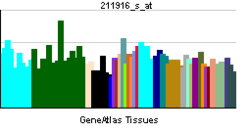MYO1A
Myosin-Ia is a protein that in humans is encoded by the MYO1A gene.[3][4][5]
The protein encoded by this gene belongs to the myosin superfamily. Myosins are molecular motors that, upon interaction with actin filaments, utilize energy from ATP hydrolysis to generate mechanical force. Each myosin has a conserved N-terminal motor domain that contains both ATP-binding and actin-binding sequences. Following the motor domain is a light-chain-binding 'neck' region containing 1-6 copies of a repeat element, the IQ motif, that serves as a binding site for calmodulin or other members of the EF-hand superfamily of calcium-binding proteins. At the C-terminus, each myosin class has a distinct tail domain that serves in dimerization, membrane binding, protein binding, and/or enzymatic activities and targets each myosin to its particular subcellular location. The myosin-1a protein is expressed by enterocytes, the epithelial cells that line the luminal surface of the small intestine. In these cells the myosin-1a protein localizes specifically to the brush border. Experiments indicate that the brush border population of the encoded protein turns over rapidly, while its head and tail domains interact transiently with the core actin and plasma membrane, respectively. A rapidly exchanging pool of the myosin-1a protein binds to the actin core bundle, which turns over on a much slower timescale.[6]
References
- ↑ "Human PubMed Reference:".
- ↑ "Mouse PubMed Reference:".
- ↑ Hasson T, Skowron JF, Gilbert DJ, Avraham KB, Perry WL, Bement WM, Anderson BL, Sherr EH, Chen ZY, Greene LA, Ward DC, Corey DP, Mooseker MS, Copeland NG, Jenkins NA (Feb 1997). "Mapping of unconventional myosins in mouse and human". Genomics. 36 (3): 431–9. doi:10.1006/geno.1996.0488. PMID 8884266.
- ↑ Donaudy F, Ferrara A, Esposito L, Hertzano R, Ben-David O, Bell RE, Melchionda S, Zelante L, Avraham KB, Gasparini P (May 2003). "Multiple mutations of MYO1A, a cochlear-expressed gene, in sensorineural hearing loss". Am J Hum Genet. 72 (6): 1571–7. doi:10.1086/375654. PMC 1180318
 . PMID 12736868.
. PMID 12736868. - ↑ "Entrez Gene: MYO1A myosin IA".
- ↑ Tyska MJ, Mooseker MS (April 2002). "MYO1A (brush border myosin I) dynamics in the brush border of LLC-PK1-CL4 cells". Biophys. J. 82 (4): 1869–83. doi:10.1016/S0006-3495(02)75537-9. PMC 1301984
 . PMID 11916846.
. PMID 11916846.
Further reading
- Hofmann WA, Johnson T, Klapczynski M, et al. (2007). "From transcription to transport: emerging roles for nuclear myosin I.". Biochem. Cell Biol. 84 (4): 418–26. doi:10.1139/o06-069. PMID 16936815.
- Hoshimaru M, Fujio Y, Sobue K, et al. (1990). "Immunochemical evidence that myosin I heavy chain-like protein is identical to the 110-kilodalton brush-border protein.". J. Biochem. 106 (3): 455–9. PMID 2606897.
- Bement WM, Hasson T, Wirth JA, et al. (1994). "Identification and overlapping expression of multiple unconventional myosin genes in vertebrate cell types.". Proc. Natl. Acad. Sci. U.S.A. 91 (14): 6549–53. doi:10.1073/pnas.91.14.6549. PMC 44240
 . PMID 8022818.
. PMID 8022818.
- Durrbach A, Collins K, Matsudaira P, et al. (1996). "Brush border myosin-I truncated in the motor domain impairs the distribution and the function of endocytic compartments in an hepatoma cell line.". Proc. Natl. Acad. Sci. U.S.A. 93 (14): 7053–8. doi:10.1073/pnas.93.14.7053. PMC 38934
 . PMID 8692943.
. PMID 8692943.
- Skowron JF, Bement WM, Mooseker MS (1999). "Human brush border myosin-I and myosin-Ic expression in human intestine and Caco-2BBe cells.". Cell Motil. Cytoskeleton. 41 (4): 308–24. doi:10.1002/(SICI)1097-0169(1998)41:4<308::AID-CM4>3.0.CO;2-J. PMID 9858156.
- Li W, Wang J, Coluccio LM, et al. (2000). "Brush border myosin I (BBMI): a basally localized transcript in human jejunal enterocytes.". J. Histochem. Cytochem. 48 (1): 89–94. doi:10.1177/002215540004800109. PMID 10653589.
- Otterbein LR, Graceffa P, Dominguez R (2001). "The crystal structure of uncomplexed actin in the ADP state.". Science. 293 (5530): 708–11. doi:10.1126/science.1059700. PMID 11474115.
- Tyska MJ, Mooseker MS (2002). "MYO1A (brush border myosin I) dynamics in the brush border of LLC-PK1-CL4 cells.". Biophys. J. 82 (4): 1869–83. doi:10.1016/S0006-3495(02)75537-9. PMC 1301984
 . PMID 11916846.
. PMID 11916846.
- Strausberg RL, Feingold EA, Grouse LH, et al. (2003). "Generation and initial analysis of more than 15,000 full-length human and mouse cDNA sequences.". Proc. Natl. Acad. Sci. U.S.A. 99 (26): 16899–903. doi:10.1073/pnas.242603899. PMC 139241
 . PMID 12477932.
. PMID 12477932.
- D'Adamo P, Pinna M, Capobianco S, et al. (2003). "A novel autosomal dominant non-syndromic deafness locus (DFNA48) maps to 12q13-q14 in a large Italian family.". Hum. Genet. 112 (3): 319–20. doi:10.1007/s00439-002-0880-6. PMID 12596055.
- Gerhard DS, Wagner L, Feingold EA, et al. (2004). "The status, quality, and expansion of the NIH full-length cDNA project: the Mammalian Gene Collection (MGC).". Genome Res. 14 (10B): 2121–7. doi:10.1101/gr.2596504. PMC 528928
 . PMID 15489334.
. PMID 15489334.
|
|---|
|
| Human | |
|---|
|
| Nonhuman | |
|---|
|
See also: cytoskeletal defects |

 . PMID 12736868.
. PMID 12736868. . PMID 11916846.
. PMID 11916846. . PMID 8022818.
. PMID 8022818. . PMID 8692943.
. PMID 8692943. . PMID 11916846.
. PMID 11916846. . PMID 12477932.
. PMID 12477932. . PMID 15489334.
. PMID 15489334.